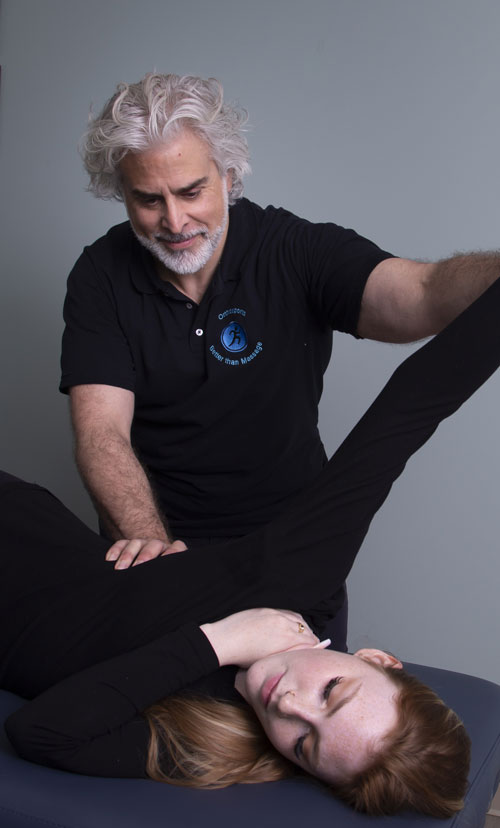Massage Types
What is an Orthopedic Massage?
An orthopedic massage uses advanced techniques and goes a step further than a deep tissue massage by pinpointing the tendons, tissues, and fibres that actually cause pain or immobility.
Compared to other types of massage, orthopedic massages are more focused on the physical benefits rather than the emotional or stress relieving ones. With a greater grasp of the human body’s anatomy, orthopedic massage therapists understand how manipulating the musculoskeletal (muscle/bone) system can provide near instant pain relief for patients. They also understand how pain in one part of the body can be caused by an issue elsewhere (referral pain) and are experts at diagnosing the real issue behind what’s causing you trouble.
Why Should I Get an Orthopedic Massage?
Because it works! Instead of spending more time and money at a physiotherapist, chiropractor, or deep tissue masseuse, you can relieve your pain and regain mobility within one orthopedic massage treatment. Most physiotherapists, chiropractors, and deep tissue massage therapists fail at providing immediate, long-lasting pain relief for one simple reason. They treat muscles, not tendons. The majority don’t even know where tendons are. By treating the symptom instead of the cause, they provide pain relief that may last a few days or a couple weeks before you have to book another appointment with them. An orthopedic massage from Orthopedic Massage on the other hand will target the pain causing tendons and provide immediate pain relief and increased mobility. Its effectiveness is so powerful that most of our patients don’t come back in for another treatment before a great amount of time has passed, or at all.

How Come I’ve Never Heard of an Orthopedic Massage Before?
Though the advanced techniques involved with an orthopedic massage have been around for more than 50 years, the discipline is just starting to gain recognition in the medical community for its effectiveness at eliminating pain and increasing mobility. With its roots dating back to the 1940s, orthopedic massage therapy is still a relatively young treatment for chronic or injury related pain. As such, scientific studies are just beginning to empirically document the effectiveness of its techniques. Those studies have found orthopedic massage therapy can provide an immediate anaesthetic (painkilling) effect to injured areas. This in turn helps the healing process because mobility is important for affected tendons, tissues, or fibres, and pain usually inhibits this movement. With the pain removed the affected areas are able to move more freely and reorganize the damaged tissues back to their normal state.
Does an Orthopedic Massage Hurt?
An orthopedic massage may cause slight discomfort during its administration, but an experienced therapist will work within your comfort level to ensure you aren’t caused any pain. Pain is a relative term and it differs from person to person. Some people are able to withstand more of it, some people aren’t. The reason most patients decide to try an orthopedic massage is because nothing else has worked when it comes to relieving their pain or stiffness. Although the advanced techniques do cause some discomfort due to their penetrating nature, this is immediately offset by the instant pain relief the treatments provide. Instead of calling an orthopedic massage ‘no pain, no gain’, a more accurate motto would be ‘no discomfort, no penetration, no effectiveness, no relief’.
Head
• Chronic headaches
• Tempo mandibular joint dysfunction (TMJ)
Neck
• Acute muscle/nerve pain
• Spasms
• Whiplash
• Referred pain
• Poor neck range of motion
Shoulders
• Rotator cuff injuries
• Shoulder impingement
• Thoracic outlet syndrome
• Bursitis
• Frozen shoulder
• Bicipital tendinitis
Back
• Muscle pain
• Nerve pain
• Functional Kyphosis
• Sacroiliac joint dysfunction
• Bulging disc pain
• Functional Scoliosis
• Lumbar lordosis
Arms/Hands
• Medial & lateral epicondyle pain (tennis/golf elbow)
• Carpal tunnel syndrome
• Strained muscles/joints
• Wrist/elbow tendinitis
Hips/Legs
• Sciatica
• Hip capsule problems
• Iliotibial band (ITB) friction syndrome
• Patellar tendinitis
• Chondromalacia (runner’s knee)
• LCL/MCL sprains
• ACL/PCL instability
• Other knee injuries
Ankles/Feet
• Achilles tendinitis
• Ankle sprains and strains
• Plantar fasciitis
• Bunions
• Hammertoes
• Neuromas
We help you manage chronic pain. Faster!
Orthosports can help get you fixed up.



